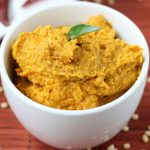
Pumpkin Thogayal
Ingredients
- 200 gr Pumpkin (Parangikkai)
- 2 tbsp Urad Dal *
- 7-8 red chilis
- 2 pinches asafoettida **
- salt
- 1 piece tamaraind *** small
- 1 tsp oil
- 1-2 tbsp coconut scrapped
Instructions
-
Cut off the hard skin of the pumpkin cut into 4 pieces and chop them into small cubes.
-
In a pan add oil and sauté the urad dal, red chilli and tamarind, until the dal turns golden brown.
-
Keep it aside and saute the cubed pumpkin in a low flame for 10 minutes until the pumpkin shrinks.
-
Once it is done, let it cool down and then grind it to a smooth paste along with the roasted urad dal, the red chilli, salt, asafoetida, tamarind and coconut.
-
Do no add water while grinding, as the pumpkin will ooze out water.
-
Only if needed sprinkle little water.
-
By now the pumpkin thogayal is ready to serve.
-
It is a simple chutney which generally is mixed with hot rice smeared with ghee.
Recipe Notes
* bean grown in the Indian subcontinent
** Asafoetida, also called hing or heeng, is an astonishingly pungent spice, consisting of the dried gum resin from members of the giant fennel family, Ferula, which grows in Central Asia.
Asafoetida is an important spice in Indian cuisine, introduced there through the Moghul empire. Its name derives from the Persian word aza, which means mastic resin, and Latin foetida, which means stinking, a clue as to its powerful, distinctive odour.
This ground asafoetida is particularly strong-smelling, with noticeable garlic notes. When heated it gives an onion-like aroma, and is a popular spice among the Brahmin and Jain sects, who are forbidden the use of garlic and onion in their cooking.
Traditionally in Indian cooking, asafoetida is fried first in order to mute its powerful taste, rather than being added ‘neat’. Due to its strength, use it sparingly in dishes such as chat masala, pickles and dals.
*** Tamarind is a fruit used widely as a spice in Indian cuisine as it imparts sharp tart flavour. The tamarind fruits are long and thin often resemble a human finger, with bulges due to its pod-like appearance. Each fruit contains around five small seeds; each seed is covered by the pulpy fruit, which is used for culinary purpose. The outer skin of tamarind is eatable when the tamarind fruit is young and it becomes dried shell-like thing when becomes ripen.
Blog Jeyashri’s Kitchen / September 23, 2013
